 Released in 2016, Sharp Practice (version 2) is a wargaming ruleset for large skirmishes in the black powder time period. This includes anything from the French and Indian War to the American Civil War, but realistically could be used for small skirmishes even before the FIW. You can expect to use about 50-100 models per side and likely utilize movement trays. Games can be played with most board sizes but I think a 6×4 works just fine. The rules and a card activation deck can be had for around £33 at toofatlardies.co.uk or $42 at brigadegames.com in the USA.
Released in 2016, Sharp Practice (version 2) is a wargaming ruleset for large skirmishes in the black powder time period. This includes anything from the French and Indian War to the American Civil War, but realistically could be used for small skirmishes even before the FIW. You can expect to use about 50-100 models per side and likely utilize movement trays. Games can be played with most board sizes but I think a 6×4 works just fine. The rules and a card activation deck can be had for around £33 at toofatlardies.co.uk or $42 at brigadegames.com in the USA.
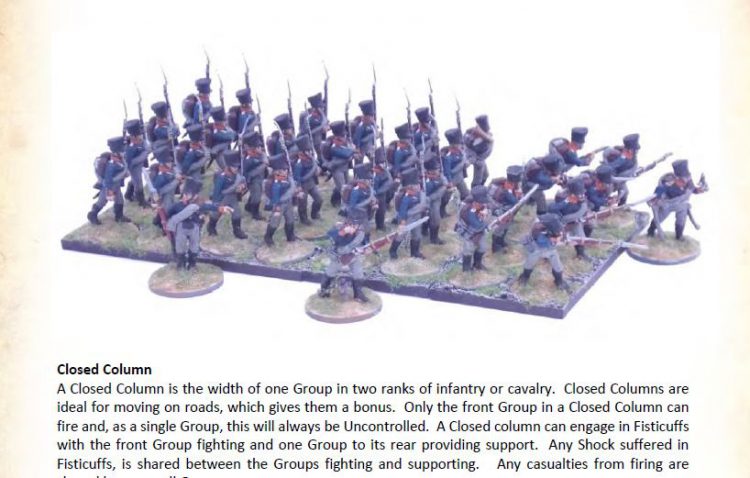
What differentiates Sharp Practice from other games of the same conflict period is the TooFatLardies focus on ‘friction’ or fog of war. If you’re coming from a game like Warhammer, Flames of War, or X-Wing, you’re used to having your troops do what you want them to do when you want them to. You have an omniscient battlefield view and you have all the information. With Sharp Practice, you’ll be able to influence your troops with resources and command decisions but just like in a real war, they won’t always be where you want them when you want them.
The other main differentiator and the thing that makes Sharp Practice so accessible for new historical players is that the model count is lower than lots of games of this time period; you’re not using large brigades or divisions and doing grand sweeping tactics. It is based on small units which makes it a lot easier to grasp and a lot easier to paint for. It also gives you some flexibility in paint – you can choose to paint different units and not have to paint 100 of the same uniform if you wish.
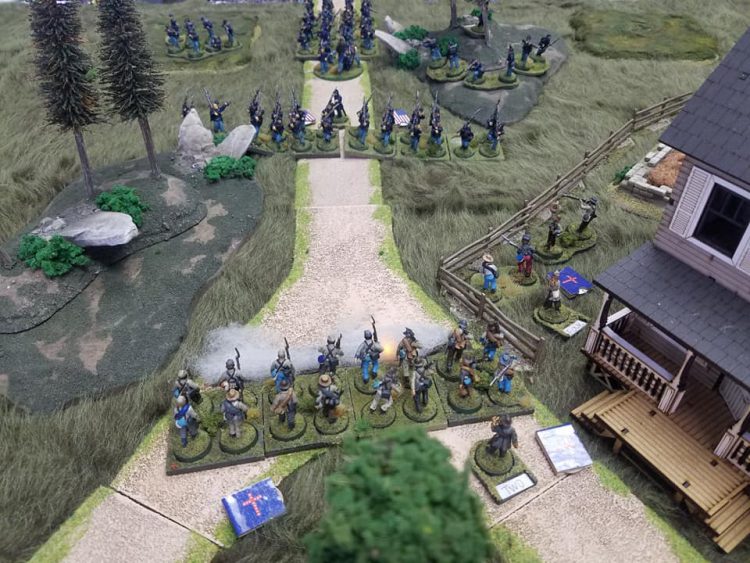
Activation System
Sharp Practice uses a card deck or chips in a blind bag to activate leaders and units. We will discuss cards here to just keep it simple, but you can use the chips instead if you wish. Each leader is given a numbered card (ie. Leader 1, Leader 2, etc), a Tiffin card (turn end), and a number of Command Cards based on game size (usually 4 per side).
A few definitions before we continue:
- Leader: one officer, NCO, rabble rouser, etc
- Group: six to eight soldiers
- Formation: a number of groups put together
- Unit: a group or formation
- Command initiative: the level or quality of a leader – how many commands they can issue
When a Leader card is drawn, that Leader can activate. That Leader can use command initiatives to:
- Activate a Unit
- Direct fire
- Create a formation out of separate groups or form new groups
These commands are counted as Activations for those units. There are other commands that can be given that are not activations, such as rallying shock (the morale modifier in this game) from groups, move and fire by himself, and form groups that are close together.
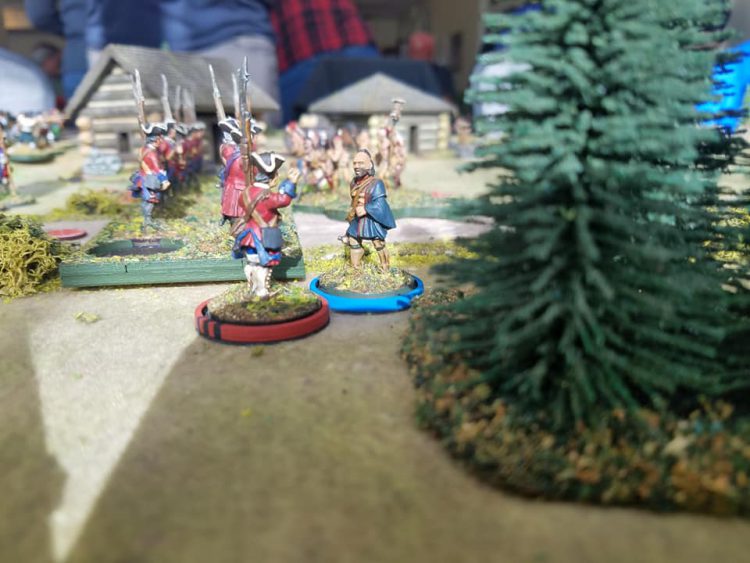
In order to activate troops they must first be on the table. This is one of the sticking points of learning the game – you have to draw the Leader card for the unit you’re wishing to bring on the table. Players get stuck sometimes wanting to use their big formation that is still off the table when they haven’t yet drawn the Leader card of the formation.
When you do draw the Leader card, you can deploy your models within a certain distance of your deployment points depending on troop type and line of sight (line infantry can deploy within 6″ of a deployment point, for instance). Deployment points are decided before the game starts, usually based on the scenario. Most players use a 40-60mm round base with a cool diorama on them.

Each unit can do two actions when ordered by their Leader. This can be two of the same action if the Leader wishes. Units can do the following:
- Move: each action gives 1D6 of random movement distance
- Loading: load their weapons if unloaded
- Present: aim as a unit, instead of at-will
- Fire: just as it sounds
Thoughts: random movement was a hard one for me at first – but I’ve learned to love it. It represents troops not doing exactly what they’re told, running through ruts and brush, or leaders not hearing commands.
Units can do two actions per turn while Leaders can issue as many orders as they have Command Initiatives – this is the #1 most confusing thing for new players. They believe if a Leader is CI5, then a unit can do 5 actions. It is something I try to make as plain as possible early on.

Command Cards
Command Cards are resources that can be used to buff up Leaders. When one comes up, the player puts it face-up in front of them. If three are dealt in a row (for either side) then a random event happens, either movement or firing. Command Cards are really the second level of strategy for players after they’ve mastered the movement and firing for troops on the ground – there are a number of ways to use them, with increasing resource cost:
- Increase the Command Initiative of a leader by one per card used for the turn (useful for rallying shock)
- Add to the dice rolled for a firing or fisticuffs of a unit
- Immediately activate a unit (not a Leader) that hasn’t activated yet (can interrupt an enemy activation)
- Immediately activate a Leader who hasn’t activated yet
- Launch an ambush with units not yet on the table
- Activate a Leader immediately (can activate again, if they’ve already activated)
- Add a bonus to a unit based on that unit’s entry (ie. extra movement, better shooting, etc)
At the end of a turn if units (not Leaders) have not yet been activated because the Tiffin card was drawn before their Leader card was, you can use one Command card to activate that unit to do two actions.

Thoughts: The resource management is very welcome in a game like this so it isn’t just move-shoot-fight-rinse-repeat.
The fog of war or friction involved with random activations, turn end, and command cards really makes sure that no game is like one you’ve had before. You can’t rely on your troops to do exactly what you’ve told them every time. The Command Cards initiating special rules helps distinguish units in a mostly human vs human war, where it may just come down to training and passion.
The cards also boost the idea of Leaders being really important – using these resources to buff up a Leader at a pivotal point can tip the balance in a fight. While the number of ways to use cards can be confusing at first, after a few games you get it.
Movement
Movement is fairly simple – roll 1D6 per action used to move and move that distance. Shock will slow you down if you’re moving toward the enemy. Cavalry get extra bonuses and unlimbered artillery are obviously slower.
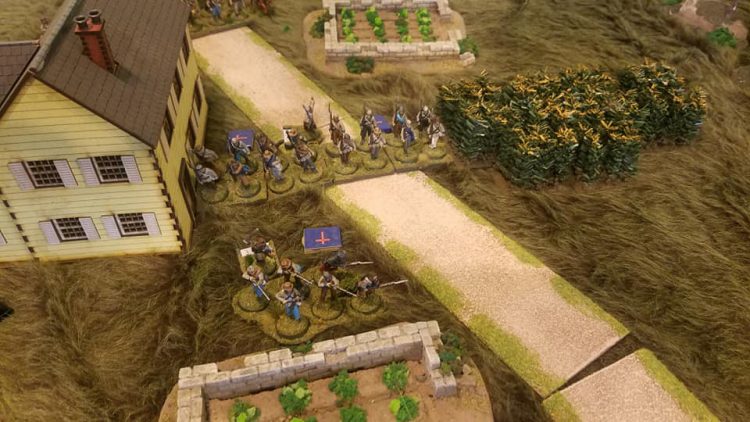
Formations can take advantage of facings and different formation types like Column, Closed Column, Line, Square, etc. Skirmishers can obviously be in skirmish formation. This is perhaps my favorite part of the game – you’re playing a small skirmish, but you still get to use drill manual formations and move around the board. I love it.
Firing System
Firing is relatively simple – groups can fire at any target in a 180 degree arc of fire. Formations fire straight forward by tracing a line from either flank of the formation. Anything in that zone gets hit by their shooting, including friendlies. Leaders can spend a Command Initiative to direct the fire at one specific target – but any groups within 4″ of the target will always share hits. Skirmishers can screen their own units and provide cover for them while also sharing hits with their main formations.

The actual process of rolling for Firing is simple – pick up one die for each model firing, add one die for each Command Initiative of the Leader who is controlling the firing, subtract one die for every two shock on the unit, then roll. At close range (usually 12″) you need 4-6 to hit, effective range of 12-24″ (for rifles or rifled muskets) you need a 5-6, and long (12-24″ for muskets, 24-36 for rifles, 24-48 for rifled muskets) you need a 6. There are various ways to get bonuses to this roll – first fire, controlled volleys (presenting), skirmishers, etc.
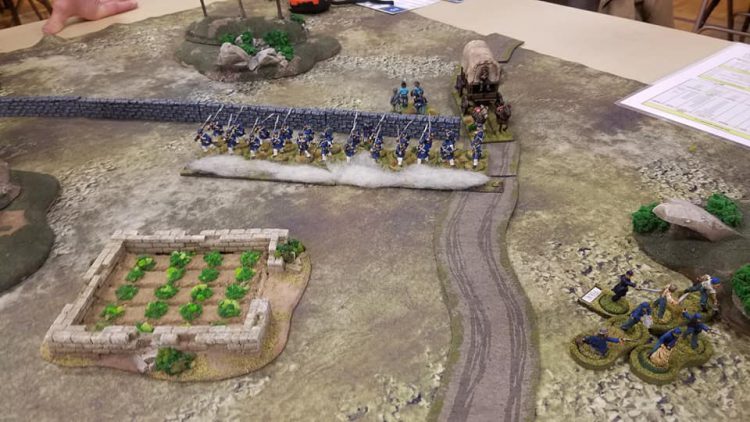
The enemy then picks up the hits, splits them equally between groups that were shot at, and rolls them again. In the open a unit takes shock on a 3-5 and a kill on a 6. It gets harder to get shock as your cover gets better. Shock is doubled if hit in the flank or rear. Groups that fire are then unloaded unless they use an action to reload.
Thoughts: Firing is the easiest thing in this game and works really well. The only sticking points can sometimes be explaining how hits are shared or forgetting to roll for leader casualties.
Morale
Shock is the method of measuring morale in Sharp Practice. Each time a unit gets fired at they have a chance of acquiring Shock. As they gain Shock it makes it harder to move (-1″ per shock when moving toward the enemy) or fire (-1 die per two shock on a unit).
Once a group has more shock than men, they start withdrawing. As an example, if a regular infantry unit has 6 men and receives 8 shock, they would withdraw 1″ per shock over the total of men – so 2″. They end their movement facing the enemy. This then happens each time they receive excess shock – so focusing fire on enemy units that are withdrawing is a good idea!
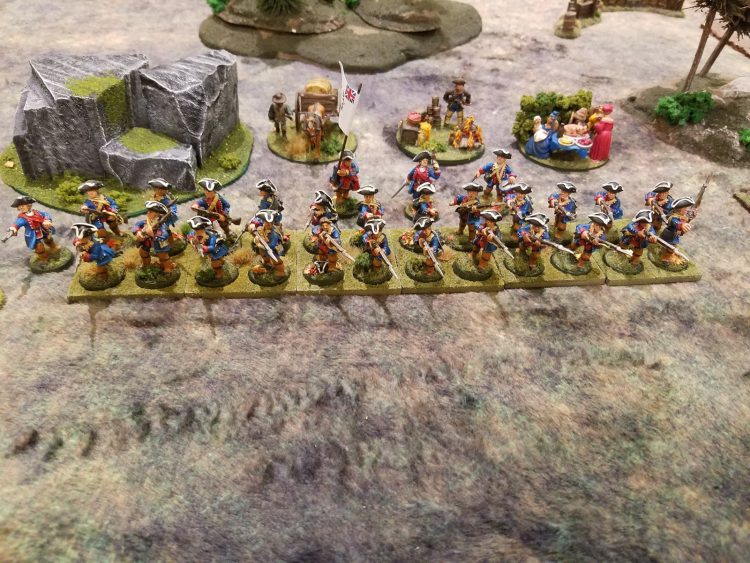
If a group has twice the number of Shock as it has models left, it breaks. They run 2D6″ + 6 directly away (quite often right off the board) from the unit that caused it. If they run through friendly troops they will add their excess shock to units they run through and also break up Formations.
Each time this happens you have to roll on the Bad Things Happen chart to see how the Force Morale has been affected. Usually a force starts with a morale of between 7-11, and can lose Force Morale for units withdrawing, breaking, being destroyed, leaders running away, etc.
Thoughts: There is a math issue with Militia being ten men – this means they’re better at taking shock than regular infantry. This gives way when the Militia are asked to do a lot of things, but it can be a sticking point. Some players use Militia at eight men instead of ten to counteract this.
Withdrawing and force morale work really well to force a leader to take care of their troops and not just do suicide attacks – I love this.

Close Combat
Fisticuffs, as it’s called in Sharp Practice, happens when two units collide with each other. A Leader commands a unit to move and if the movement roll takes them into contact then Fisticuffs will happen.
Groups in contact will fight – groups that are adjacent to them will support by adding a few extra dice. Each group gets a certain number of dice based on group type, strength, troop quality, and any other adjustments. Each side rolls their dice – a five is a kill, a six is a kill and a shock. Whoever has the most kills wins and forces the enemy back, likely lowering their Force Morale.
Thoughts: works well; though personally I would prefer group dice totals to just be one die per man, as the 6d6 per group isn’t really standardized with firing.
Characters and Story
A hallmark of TooFatLardies games is the character and story that is driven into each game. Sharp Practice helps players create characterful Leaders with Personalities, Skills, Charisma, Physique, etc. When your Leaders meet minor characters they’ll react a random way, and you can give yourself an advantage based on the characteristics of your Leader. It is very much a Sharpe movie where you can bribe characters, try to woo them, fight in duels, and even take on tasks like breaking down doors or carrying heavy objects.
Thoughts: I haven’t yet put too much effort into this beyond tasks. Fighting duels can be a dice off – not always worth the time.

Scenarios
There are six scenarios included with tons more in TFL supplements. Each scenario includes how to setup deployment points, how much random support each force gets, the objective, and how to setup terrain and minor characters.
Army Lists
There are army lists in the main rulebook for:
- French and Indian War
- American War of Independence
- Peninsular War
- American Civil War
- Indian Mutiny
There are many more available on the TFL website and in supplements. Each army list includes the infantry, cavalry, and artillery each force would use. There is one main support list that includes choices like wagons for water and ammunition, local priests, explorers, flag bearers and musicians. Point values are included in each force list.
Thoughts: army lists are excellent, support list is great – usually I just decide what support to use rather than random amount of support points. Sample forces are great for building armies to start with and making purchase lists.

Overall
Sharp Practice is my favorite game by far. It fits a niche that not many games do – smaller black powder-era engagements. That is enough to put it on my list, but the drill manual formations, force morale and shock, activation system, and character building all make Sharp Practice easily my #1.
While there are a few rules that cause confusion (chiefly each unit having two activations, while Leaders can give an order per Command Initiative), overall its a great, modern designed ruleset. TooFatLardies writers are available on Facebook and Twitter and respond quickly to questions or feedback. Check it out – you won’t be disappointed.



You must be logged in to post a comment.